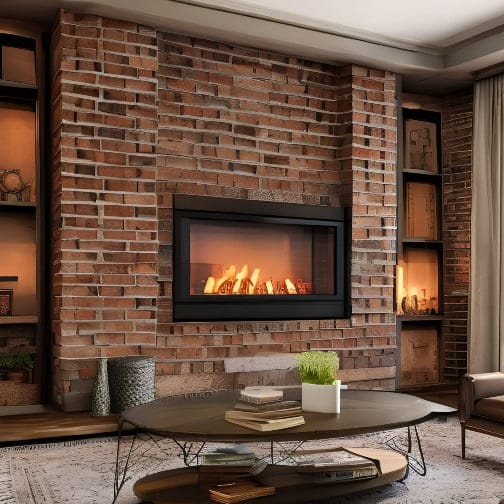fireplace FAQ
Can You Reface A Brick Fireplace?
Short Answer: Yes, you can reface a brick fireplace with materials like stone, tile, wood, or even metal. The process involves carefully applying these materials over the existing brick to enhance its look and provide a new, fresh aesthetic to your home.

When it comes to enhancing the aesthetic appeal and functionality of your home, the fireplace often plays a central role. But what if your once-charming brick fireplace now seems outdated or doesn’t blend with your evolving interior design? At Lindemann, we frequently encounter this question from homeowners: Can you reface a brick fireplace? The answer is a resounding yes, and we’re here to guide you through the process.
Understanding Fireplace Refacing
Fireplace refacing is an artful process of revamping the existing fireplace to give it a fresh, new look. This transformation often involves covering the old surface with new materials, such as stone, tile, or wood. The purpose of refacing is not just to update the fireplace’s appearance but also to improve its efficiency and durability.
The decision to reface a fireplace usually stems from a desire to update the home’s interior design or to repair aging and worn-out materials. Refacing offers a practical alternative to completely rebuilding the fireplace, saving both time and resources. Moreover, it allows homeowners to customize their fireplace to better reflect their current style and decor preferences.
The Refacing Process
Refacing a brick fireplace is a meticulous process that transforms the heart of your home. It begins with a thorough inspection to ensure the structural integrity and suitability of your existing fireplace. This stage is crucial for a safe and successful refacing project. The steps typically include:
- Inspection and Assessment: A professional evaluates the fireplace’s condition, checking for any damage or issues that need repair before refacing.
- Design Planning: Based on the inspection, a design plan is formulated, considering the homeowner’s preferences and the fireplace’s structural constraints.
- Surface Preparation: The brick surface is cleaned and prepared to ensure a strong bond with the new materials. This may involve leveling the surface or applying a new layer of mortar.
- Material Installation: The chosen refacing materials are meticulously installed. This step varies significantly depending on the material, whether it’s stone, tile, wood, or another option.
- Finishing Touches: Once the main material is in place, additional touches like grout, sealant, or trim are added to complete the look and ensure durability.
Material Options for Refacing
Choices for refacing materials range from classic stone to contemporary tile, rustic wood panels, or even sleek metal finishes. Each material brings its unique aesthetic and functional benefits:
- Stone: Offers a timeless, durable facade that complements various styles.
- Tile: Provides endless design possibilities with various colors and patterns.
- Wood: Adds warmth and rustic charm but requires careful consideration regarding heat resistance and safety.
- Metal: Creates a modern, industrial look and is typically easy to maintain.
Design Considerations
Choosing the right design for your fireplace refacing is both an exciting and challenging task. It requires a balance between personal style, the architectural character of your home, and practical considerations. Your design choice sets the tone for your living space, making it crucial to select wisely. Here are key factors to consider:
- Complementing the Home’s Style: Ensure the refacing complements the overall style of your home, whether it’s modern, traditional, or rustic.
- Color Scheme: Select a color palette that blends well with the room’s existing colors or creates a striking contrast for a bold statement.
- Material Texture and Pattern: The texture and pattern of the refacing material can add depth and character to the room. Consider how different textures interact with the room’s lighting and furnishings.
- Scale and Proportion: The size and proportion of the refacing should align with the room’s dimensions and ceiling height. Oversized designs can overwhelm a space, while too small a design might not make the intended impact.
- Functionality and Safety: Choose materials and designs that not only look good but also adhere to safety standards, especially in terms of heat resistance and durability.
The Role of Professionals
For a project like this, professional expertise is indispensable. Experienced technicians from Lindemann can assess structural concerns, navigate the complexities of material choices, and ensure that the refacing adheres to local building codes. Our team ensures a seamless transformation with utmost attention to safety and quality.
Maintenance After Refacing
Once a fireplace has been refaced, maintaining its new appearance becomes a priority. Regular cleaning is essential, especially for materials like tile and stone, to prevent soot and dust buildup. For wood surfaces, occasional treatments or sealants may be necessary to protect against heat and moisture.
In addition to cleaning, it’s important to schedule regular inspections with professionals like those at Lindemann. These inspections can identify any potential issues early on, such as cracks or loosening materials, ensuring the fireplace remains safe and functional. Timely maintenance not only preserves the beauty of your refaced fireplace but also extends its lifespan, ensuring it remains a centerpiece in your home for years to come.
Final Thoughts
Refacing your brick fireplace can significantly change the ambiance of your living space. Whether seeking a modern update or a restoration to its former glory, Lindemann has the expertise to bring your vision to life.
